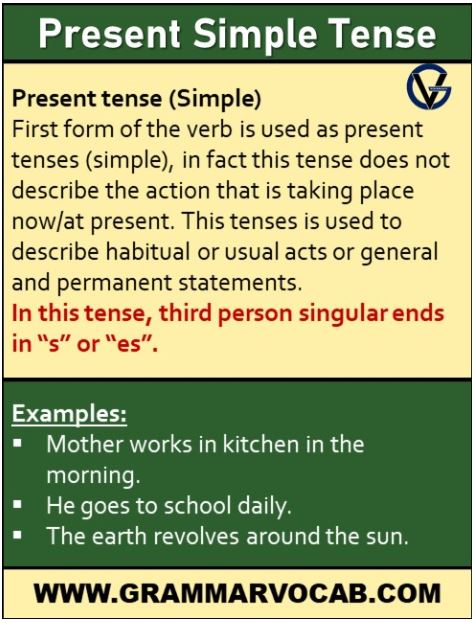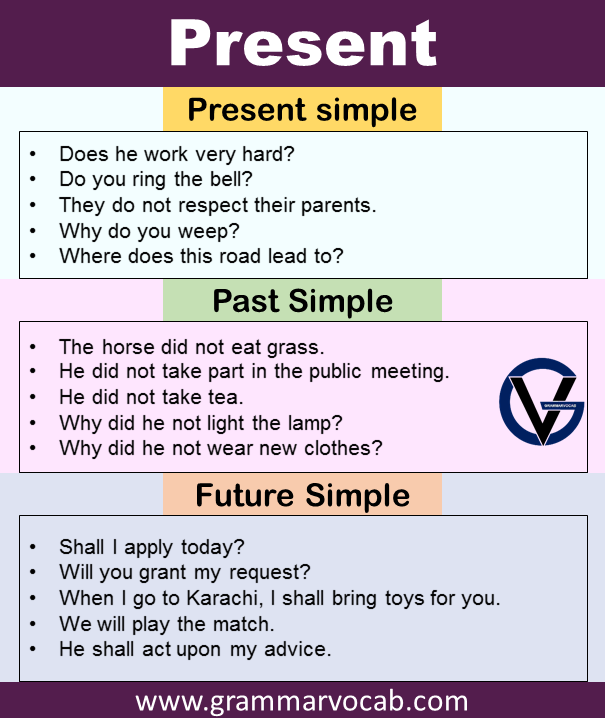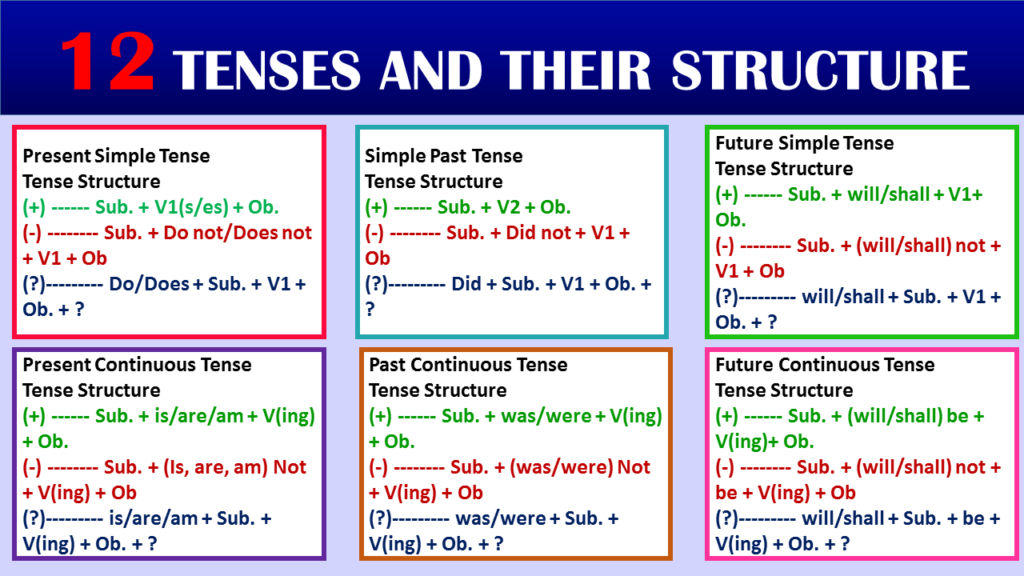English grammar can be a challenging subject for many learners, but it’s an essential skill to master if you want to communicate effectively in English. One of the fundamental aspects of English grammar is understanding verb tenses. Tenses help us convey when an action took place, whether it is happening now, has already happened, or will happen in the future. In this comprehensive guide, we will explore the 12 basic English grammar tenses with examples to help you gain a deeper understanding of how they work.
Before we dive into the individual tenses, let’s start with a brief overview of what verb tenses are and why they are important.
Verb Tense Definition
Verb tenses are grammatical forms that indicate the time of an action, event, or state in relation to the present. English has 12 basic tenses, which are categorized into three main groups: past, present, and future. Each tense serves a specific purpose, allowing speakers and writers to convey precise information about when something occurred or will occur.
Present Tense (Simple)
The first form of the verb is used as present tense (simple) in fact this tense does not describe the action that is taking place now/at present. This tense is used to describe habitual or usual acts or general and permanent statements.
In this tense, third-person singular ends in “s” or “es”.
Structure: Subject + Base Form of the Verb (e.g., I work)
Examples:
- Mother works in the kitchen in the morning.
- He goes to school daily.
- The earth revolves around the sun.
- Does he work very hard?
- Do you ring the bell?
- They do not respect their parents.
- She reads books every evening.
- They play soccer on Saturdays.
- I live in New York.
- Why do you weep?
All these examples describe habitual or usual actions and general truths.

Present Tense (Continuous)
This tense describes the action that is taking place Now/ At present.
It is made from the present of “to be” with the “ing” form of the verb.
Structure: Subject + Am/Is/Are + Verb + -ing (e.g., He is working)
Examples:
- I am walking to the door.
- The doctor is examining a patient.
- The teacher is delivering a lecture.
- Is Aslam plucking flowers?
- You are not working hard.
- I am watching TV right now.
- They are playing basketball this evening.
- She is studying for her exam.
- Are they flying kites?
- Is he solving the sums?
- Is he writing something?
Most verbs of sense feeling or perception are generally not used in the continuous form, useless, of course, they are used in some special sense. These verbs describe actions that happen automatically or state beyond human control.
Example:
- I see a man loitering in the street.
- I hear children making a noise in the garden.
A list of some of these verbs is given below:
See, hear, smell, taste, feel, notice; know, understand, remember, recollect, forget; love, hate, like, dislike, want, wish, desire; Suppose, mean, recognize, belief, think, refuse, seem;
This list does not claim to be exhaustive.
Present continuous tense is also used for future tense.
Example:
- Tomorrow I am leaving for Dubai.

Present Perfect Tense
Present perfect English tense tells us about an act that is completed by now. It does not tell us when this completed act happened. It is only concerned with its present completed state and its relation with now.
Structure: Subject + Have/Has + Past Participle (e.g., We have eaten)
The present perfect tense is made by prefixing has or have to the third form of the verb.
Apart from the two adverbs “already “and “not yet” which are normally used with the present perfect tense, the word “since” and “for “are also generally used with this tense. “For” is used for “a given length of time tills now”.
Example:
- I have already completed two chapters of the book.
- I have not yet taken my lunch.
- I have visited Paris several times.
- She has never seen a live concert.
- They have finished their homework.
- Has my aunt read the newspaper?
- The monkey has not climbed up the tree.
- The passenger has not died of cold.

Present Perfect Tense (Continue)
When we wish to describe an action that is not completed by the present moment but is still going on, we use the present perfect (continuous) tense i.e. we add the idea of the present continuous to the idea of the present perfect.
Present perfect continuous is made by the use of ‘has’ or ‘have’ as in the case of present perfect (simple), followed by “been” and “ing” forms of the main verb.
Structure: Subject + Have/Has + Been + Verb + -ing (e.g., They have been working)
Example:
- I have been standing in the rain waiting for the bus for two hours.
- She has been working in the kitchen all morning.
- He has been sleeping soundly for the last three hours.
- I have not been reading the newspaper for many days.
- Has he not been sleeping for the last four hours?
- I have been reading this book for two hours.
- He has been playing the guitar since morning.
- We have been waiting for you.
- It has not been raining since morning.
- Has he been knocking at the door for five minutes?
- What have you been doing since noon?
Past Tense (Simple)
We use the past tense when we want to talk about some past that has been completed. we also put our verbs past act that has been completed. we also put our verbs into the past simple tense if we want to describe actions happening one after the other, as in a story.
Past tense is made by using the second form of the verb. The word “ago’ is associated with this tense in the same way that “since” and “for” are with the present perfect. The word “ago’ points to the date or period of time measured back from the present.
Structure: Subject + Past Form of the Verb (e.g., She visited)
Examples:
- My father died five years ago.
- The servant swept the room only a few minutes ago.
- He wakes me up at seven.
- The horse did not eat grass.
- He did not take part in the public meeting.
- He did not take tea.
- Why did he not light the lamp?
- He visited London last summer.
- They finished the project yesterday.
- We watched a movie last night.
- Why did he not wear new clothes?

Past Tense (Continuous)
We use the past continuous tense for a past action that has not finished. if we want to talk about some past act that is completed while another is still going on, we use the past continuous for the longer unfinished action and the past simple for the shorter completed action.
Certain verbs are not used in the past continuous form. They are the same verbs that have been discussed in the case of the present continuous to form some verbs of sense, feeling, and perception.
Structure: Subject + Was/Were + Verb + -ing (e.g., They were studying)
Example:
- He was singing a song.
- He was doing useful work.
- She fell down when she was running.
- The workers were wasting time.
- She was not combing her hair.
- Was he groaning with pain?
- Was the car not running at full speed?
- She was reading a book when the phone rang.
- They were playing in the park when it started raining.
- We were driving to the beach when we got a flat tire.
- He was not speaking the truth.

Past Perfect Tense
Past perfect tense describes an action completed before the last moment we are talking about. This tense bears the same relation to the past time as the present perfect tense does to now.
Structure: Subject + Had + Past Participle (e.g., I had finished)
This tense is often associated with time clauses and is commonly used in the Reported speech. The past perfect tense is made by prefixing “had” to the third form of the verb.
Example:
- we had taken our seats before the show began.
- He said that he had seen him at the railway station on Tuesday last.
- Had the clock struck ten before you came?
- Had you taken your meal after we left?
- His fame had spread far and wide before he died.
- I had never eaten such a delicious fruit before.
- Had you not already written an insulting letter?
- He had already eaten when I arrived.
- She had left before I could talk to her.
- They had studied a lot for the exam.

Past Perfect (Continuous)
Past perfect continuous tense is used when we wish to describe an action that was not completed by a certain date or time in the past.
This tense is made by the use of had as in the past perfect simple followed by “been” and “ing” forms of the main verb.
Structure: Subject + Had + Been + Verb + -ing (e.g., We had been waiting)
Examples:
- He had been living in Lahore since 1947.
- I had been attending the office for two days.
- Had he been living in this house since 1970?
- Had he been putting me off for many days?
- He had not been wasting his time for two hours.
- Why had the child been weeping since morning?
- By the time I called her, she had been cooking for two hours.
- They had been working late into the night before the project was due.
- I was tired because I had been running for an hour.
- Had they not been checking the accounts since evening?
Future Tense (simple)
The future tense is used to describe an act that is going to happen in the future.
Structure: Subject + Will/Will not + Base Form of the Verb (e.g., I will travel)
There are a number of ways to make the future tense.
- Use of shall will with the first form of the verb.
Shall is used with first-person singular and plural and will with second and third person. It is used vice versa if the act has to be emphasized.
- Use of going to with the first form of the verb.
- Use of present continuous tense.
Generally, the use of shall, will, or going to does not make any difference in the meaning of a sentence. Sometimes. However, it does. Going to is normally used when the speaker intends the action or feels that the action is certain to happen.
Example:
- I shall not believe you.
- She will know the answer tomorrow.
- Aric is going to study French.
- Shall I apply today?
- Will you grant my request?
- When I go to Karachi, I shall bring toys for you.
- We will play the match.
- He shall act upon my advice.
- She will call you tomorrow.
- They won’t attend the meeting.
- We will visit the museum this weekend.
Present continuous tense is used to announce a future event which is already fixed or arranged. It is especially common with the verbs of movement.
Example:
- she is leaving for pairs tomorrow.
- Siddiqui’s are coming to dinner on Friday next.

Future Tense (Continuous)
This tense is used to describe an action in progress at some future moment.
This tense is made by using “shall be” and “will be” followed by the “ing” form of the verb.
Structure: Subject + Will be/Will not be + Verb + -ing (e.g., He will be working)
Example:
- They will be taking a rest at 3 o’clock.
- I shall be writing a letter to Rashid in a week’s time.
- Will they be doing their duty?
- It will be raining.
- He will be drawing a picture.
- Will he be offering the prayer?
- The price of ghee will be going up.
- At 3 PM tomorrow, she will be taking her exam.
- They won’t be traveling during the holidays.
- I will be cooking dinner when you arrive.

Future Perfect
Future Perfect tense tells us about an activity that will be completed by a certain future date.
It is made by using “shall have” and “will have” followed by the third form of the verb.
Structure: Subject + Will have/Will not have + Past Participle (e.g., They will have finished)
Examples:
- I shall have taken my dinner by 10 o’clock
- She will have left the country by tomorrow.
- Will you have taken a bath before sunrise?
- Will you have finished work before we arrive?
- Will she have taken food before the sun sets in?
- Will the birds have gone to their nest?
- She will not have got the bus till now.
- By the time you arrive, I will have completed the report.
- She won’t have eaten by 8 PM.
- We will have graduated by next year.
Note: Future perfect tense is not used with time communication. The present perfect tense is used instead.
Example:
- I shall wait here until you have finished your work
There is also a Future perfect continuous Tense but it is not often used.
Examples:
By next year he will have been working in this factory for five years.
Images











